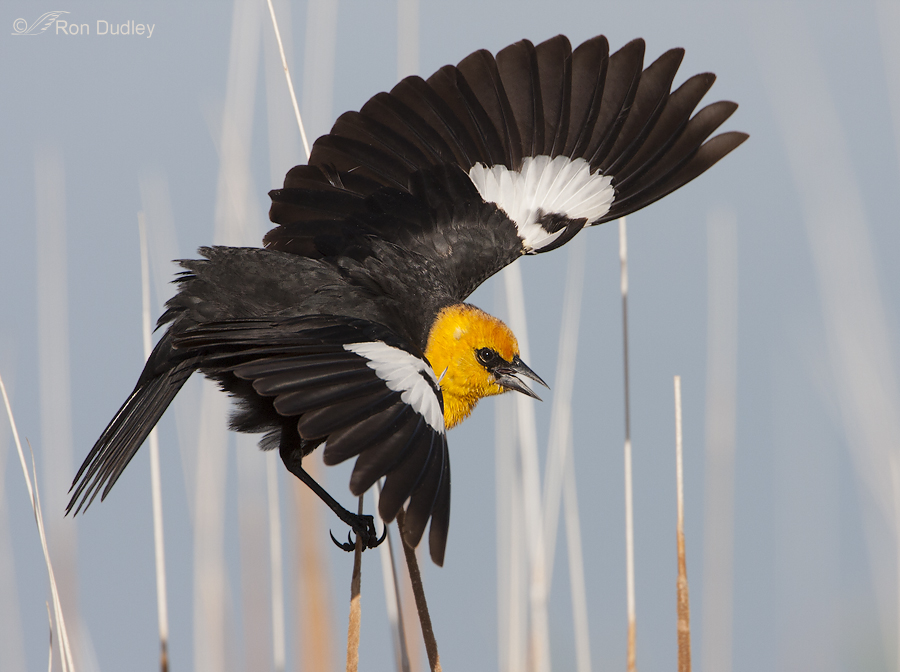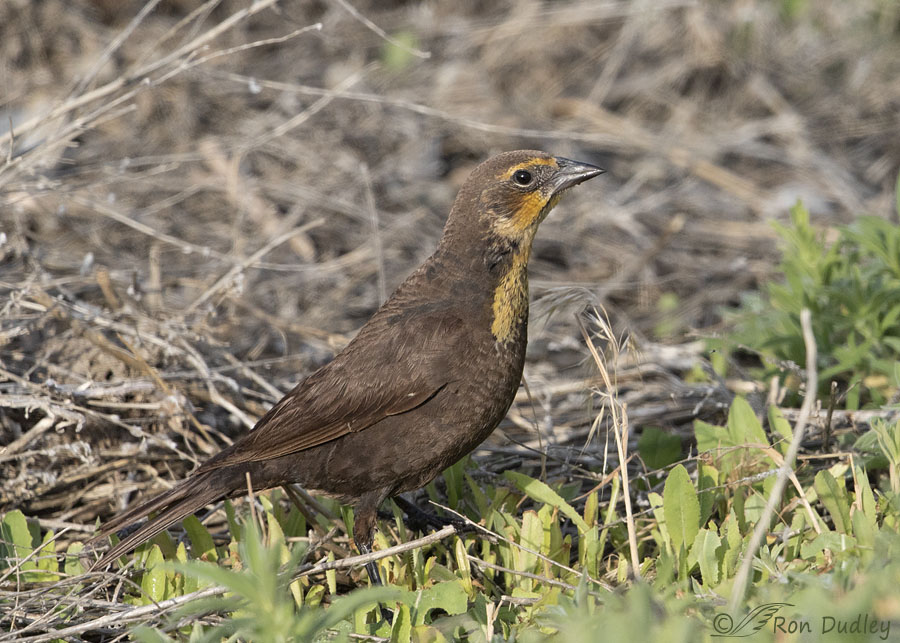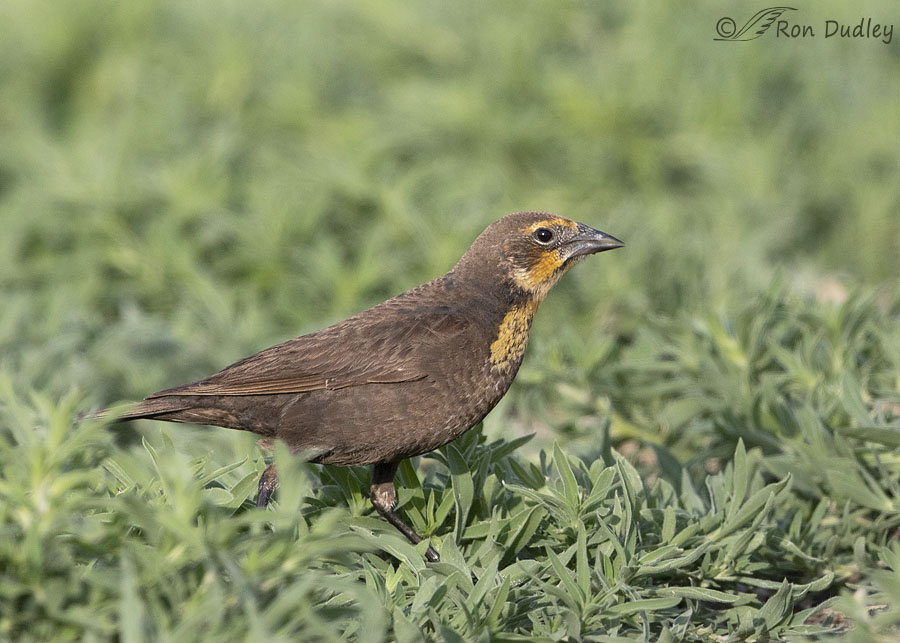Four blackbird posts in a row. You may wonder if I’ve gone daft but there’s a method to my madness. I hope.
Three days ago I posted photos of a male Yellow-headed Blackbird. I had no master plan in mind when on the next day I posted photos of both a male and a female Red-winged Blackbird with an explanation of how to identify females. Then yesterday, when I posted more photos of another male Yellow-headed Blackbird, blog follower Lyle Anderson made a comment that implied the obvious question.
“I glanced through your past photos of Yellow-headed Blackbirds and couldn’t find a female.”
I interpret Lyle’s implied question to go something like this: “You’ve now posted photos of three of the four blackbird species/sex combinations found in your area so why have you left out female Yellow-headed Blackbirds?”
That implied question niggled at me, thus today’s post.

1/1600, f/7.1, ISO 500, Canon 7D, Canon EF 500mm f/4L IS II USM + EF 1.4 III Extender, not baited, set up or called in
I’m including this photo of a displaying male Yellow-headed Blackbird for the sake of comparison to the female below.

1/2000, f/6.3, ISO 800, Canon 7D Mark II, Canon EF 500mm f/4L IS II USM + EF 1.4 III Extender, not baited, set up or called in
I looked through my image files and found a couple of photos of this female Yellow-headed Blackbird taken at Bear River MBR on May 11, 2015. Females are more shy than males so my photos of them are extremely limited.
Females are much more muted in plumage than males. They’re mostly brown (sometimes appearing dull black) with yellow primarily on upper breast, throat and neck and a yellow eyebrow stripe. Subtle white streaking often merges yellow breast with brown abdomen. Females of this species are the only New World blackbird females with yellow on the head.

1/2500, f/6.3, ISO 800, Canon 7D Mark II, Canon EF 500mm f/4L IS II USM + EF 1.4 III Extender, not baited, set up or called in
Another photo of the same female taken a few seconds later when she moved to a more attractive setting. This one isn’t quite as sharp as the first one.
OK, no more photos of blackbirds on Feathered Photography, at least for a while. My job here is done. And Lyle, you rascal you, look what you instigated…
Ron
PS – Recently I mentioned that I bought a new rain guage this spring. Yesterday that thing was finally put to good use. We had .9″ (9/10ths”) of rain by about 5 PM and it rained some more after that. Rain was literally pouring off the roof of my camping trailer. Some areas of the valley got 1.25″ of rain and the nearby mountains got about a foot of new snow.
For some of you that may not sound like a lot but in this desert, and in the current severe drought, it’s huge! I’m anxious to check my guage again this morning after it gets a little brighter out there. Maybe we got even more.
Addendum: We did. This morning it reads 1.1″.


She is quite the lovely lady. I don’t think I would have guessed that she’s a blackbird without your online classroom. 🙂 Congrats on the rain. I’m jealous — only single-digit chances of precipitation in our 10-day forecast and up in the 80s on Friday.
Oh, and I double-dog-dare you to make it five! 😉
And I double-dog-decline your dare, Marty. I could do another one on the juveniles of both blackbird species but sometimes I do know when to quit…
She’s a very lovely lady — I would not be disappointed to find her in my yard, either! Nor would I be disappointed to get your 9/10” of rain (or even 1/2”) — alas, we’re heading to the 80s this week, no relief in sight.
Thanks for posting La Femme. And thanks to Lyle for getting into your head! 😎
PS — Yesterday afternoon, a handsome young male Bullock’s Oriole visited my fountain, not long after a Hooded had been there.
Chris, you might be surprised how often Lyle gets into my head.
Still waiting for my first of year Bullock’s.
Great photos, as usual. However, I have to get picky and take exception with your assertion that Yellow-headed Blackbirds are the only females with yellow on the head in New World Blackbirds. Female meadowlarks have yellow throats and many female orioles have yellow on the head. I know we don’t typically think of them as blackbirds but they are members of the New World Blackbird Family. This species is the only species we call by the name blackbird where females have yellow on the head. (At least in North America.)
Dan, as you say we don’t typically think of meadowlarks and orioles as blackbirds and regarding meadowlarks I don’t think of the throat as being part of the head. To me it’s part of the neck.
Here’s what Cornell’s Birds of the World has to say in their Yellow-headed Blackbird account: “Other female icterids lack yellow on head.” I just went with that but it seems you have at least a partial point about orioles and maybe even meadowlarks if we’re including the entire family
I know, sometimes I can be a bit too literal or picky. I think it’s an old habit of trying to get my students to be precise about what they wrote. My students were mostly senior Biology majors and grad students and my expectations from them was higher than when I dealt with freshmen or the general public. It’s a minor point and we all understand your point well and it helps to distinguish these birds. What’s important is knowing male from female which your photos beautifully illustrate.
There’s never anything wrong with trying to get students to be precise, especially at that level. I applaud you for it.
I love the first balancing act shot! I don’t see many yellow-headed blackbird females. They are more elusive than the redwing females.
Rain wise, I have tuna cans I use as water gauges when I water the lawn. the tuna cans are 1 and 1/4 inch deep. I have one outside left over from last year and when I looked at it the can was filled to the brim. We need a few more soaking storms to put a dent in our drought.
April, A few more would be best but this one was very helpful, at least for the short term.
Beautiful shots!!
If males are brought up right they will “Remember the Ladies” most of the time!!
Many thanks for sharing.
Don’t know for how long this will last, but I’m hopeful!
Good to have you back again, Dick. I wish we could figure out what’s causing you to usually be unable to view my posts.
God bless the females, but that first photo of the male is awesome. My wife and two daughters always make sure I “remember the ladies.” Excellent post.
Thanks, Lyle. I have a Facebook friend who regularly reminds me to give the ladies their due.
Nice to see her. After seeing the female red-wing with her muted red, I think I would have suspected this would have been the female yellow-headed. She does have more yellow in her markings with the upper breast extension but it seems the coloration of the head-face are quite similar. Very nice to see because I’m quite sure this will be a forever elusive bird for me. Many thanks!
Thanks, Kathy. It can become more confusing when you throw juveniles into the mix. Perhaps I should have included one but I didn’t think of it in time.
Hooray for rain.
I hope you get the necessary follow-up rain as well.
And thank you for showing us this subtle charmer. Not nearly as dramatic as her mate, but definitely still lovely.
EC, if anyone understands how exciting it is for us to get that much rain now, it’s you.
Oh yes.
And nine inches in a day is unheard of here. In my part of Oz if we get over an inch we are doing happy dances.
We didn’t get 9″. We got 9/10ths of an inch. In this font that period is hard to see.
Nice! Not as drastic a difference as red winged but would still make one “think” a bit about it. 😉 As usual, they are colored to “blend in” and are pretty in their own right.
Glad you got the rain – been drizzling here the past few day – we also need it! Now if the wind will “give it a rest” – good luck with that!
Judy, thankfully we didn’t have as much wind preceding this storm as we usually do.
I often think of the Montana wind this time of year and those memories are rarely, if ever, fond ones..
As Abigail Adams wrote to her husband John, “Remember the Ladies…”, and so you have. As well, your images show a very dignified lady. Her husband, or mate as the case may be, should be proud.
Lyle, when it comes to birds I occasionally need to be prodded to “remember the ladies” – one of the reasons for this post.